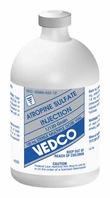Pronunciation
ah-TROW-peen - Pronunciation guide
Brand Names
- AtroJect SA
- Atropine Sulfate Injection
- Atropine Sulfate Injection 1/120 Grain
- Atropine Sulfate Injection 15 mg/mL L.A.
- Atropine Sulfate Injection SA
Description
 Atropine, which is a purified form of the tropane alkaloid found in the deadly nightshade plant, has been known and used for centuries. Atropine counteracts the effects of acetylcholine, which is a chemical compound that acts as a neurotransmitter in the peripheral, central, autonomic, and somatic nervous systems.
Atropine, which is a purified form of the tropane alkaloid found in the deadly nightshade plant, has been known and used for centuries. Atropine counteracts the effects of acetylcholine, which is a chemical compound that acts as a neurotransmitter in the peripheral, central, autonomic, and somatic nervous systems.
By competing with the receptors on sensitive muscle cells that are primarily not under conscious control in the heart, lungs, sweat glands, eyes, intestines, and urinary system, atropine is used to treat breathing problems, abnormal heart rhythms, eye problems, and in the treatment of overdoses with organophosphates found in older types of dewormers and some fly sprays and insecticides.
Usage
Injectable atropine is often used by veterinarians in emergency situations as a bronchodilator with horses having difficulty breathing during acute episodes of heaves or chronic obstructive pulmonary disease.
Atropine is used to treat abnormal heart rhythms, especially those that occur during anesthesia or in response to other drugs.
Veterinarians use atropine topically to dilate the pupil of the horse's eye during examinations and as a part of treatment to decrease the pain of recurrent uveitis and other diseases of the eye where dilating the pupil helps prevent formation of scars or adhesions that might permanently interfere with normal pupil function.
Atropine is used to treat poisoning or overdose with organophosphates contained in some types of older dewormers and fly sprays.
Dosage and Administration
 Atropine Atropine |
||||
|---|---|---|---|---|
| Method | Dosage (click row for calculator) |
Concentration | Period | Duration |
| Opthalmic | 1 or 2 drops | 1% | Every 3 to 24 hours | NA |
| Intravenous, Intramuscular or Subcutaneous injection | 0.03-0.06 mg/kg2 | 0.54 mg/ml1 | Treatment | NA |
| Intravenous, Intramuscular or Subcutaneous injection | 6.5 mg/100lb | 0.15 mg/ml1 | Treatment | NA |
Notes:
|
||||
Side Effects
Drug side effects are commonly dose-related and include increased heart and respiratory rates, slowing of gastrointestinal motility, abdominal pain, dilation of the pupil, and dry mouth and mucous membranes.
Precautions
Some horses are susceptible to developing colic caused by the slowing of the gastrointestinal tract due to administration of atropine. Extreme caution should be taken with use in horses with kidney or liver disease due to increased severity of side effects.
Atropine should be used with extreme caution in foals.
Atropine is FDA-approved for use in horses and is a prescription-only drug. U.S. federal law mandates that this drug be used by or on the prescription of a licensed veterinarian.
Atropine is prohibited in most sanctioned competitions. It is important to check with the appropriate regulatory group.
Interactions
Atropine interacts with antihistamines, phenothiazine tranquilizers, and some painkillers. The likelihood of side effects increases when long-term corticosteroids are used to treat a horse with chronic obstructive pulmonary disease.
Overdose
Drug overdose increases the severity of side effects, and, in addition, may cause restlessness, muscular tremors, loss of coordination, convulsions, and respiratory depression, which, if severe, may lead to death.
Images
 Atropiine Opthalmalic Solution
Atropiine Opthalmalic Solution
 Atropine Sulfate Injection
Atropine Sulfate Injection
Literature
